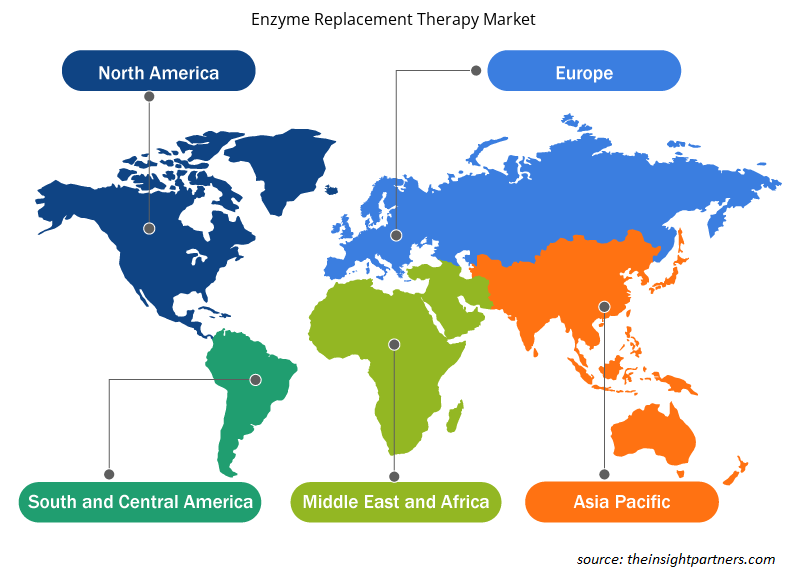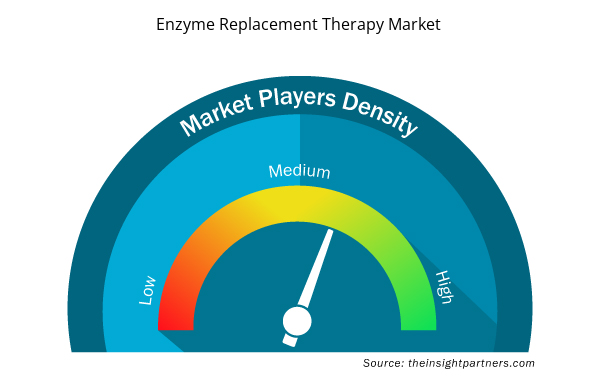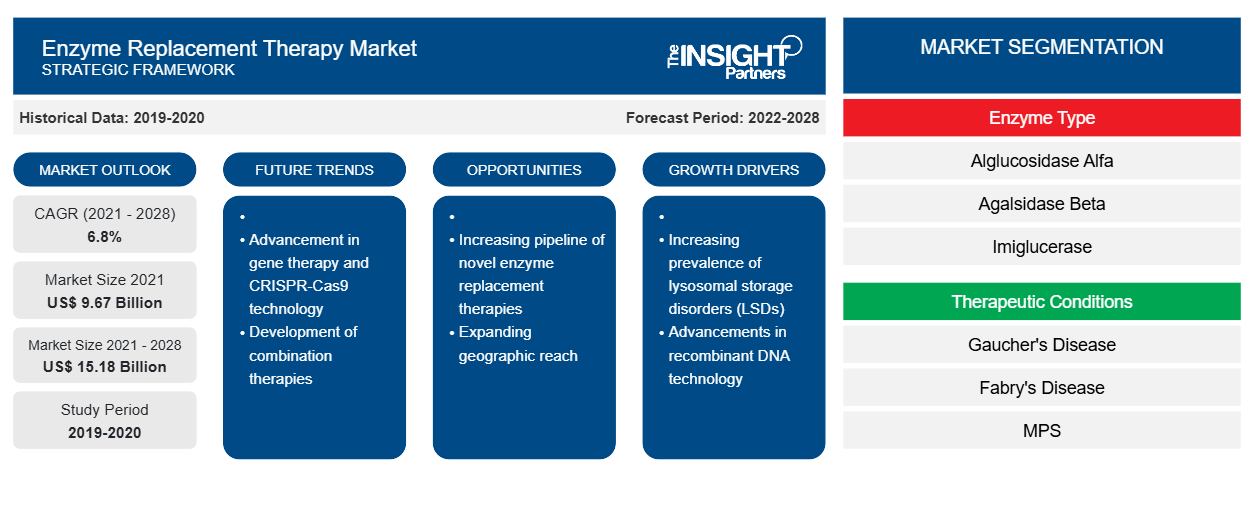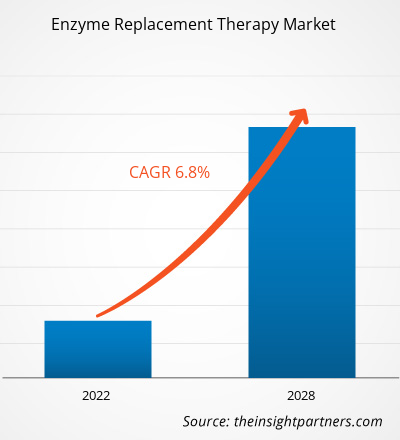Der Markt für Enzymersatztherapien soll von 9.673,39 Millionen US-Dollar im Jahr 2021 auf 15.184,70 Millionen US-Dollar im Jahr 2028 wachsen; von 2022 bis 2028 wird mit einer durchschnittlichen jährlichen Wachstumsrate von 6,8 % gerechnet.
Eine Enzymersatztherapie ( ERT ) wird durchgeführt, um angeborene Enzymmängel zu behandeln. Dabei werden Enzyme oder Proteine mit enzymatischer Aktivität verwendet. Tierische, menschliche und rekombinant hergestellte Enzyme sind einige der für die Behandlung benötigten Enzymquellen. Die Therapie wird im Allgemeinen bei seltenen lysosomalen Speicherkrankheiten angewendet, darunter Morbus Pompe , Morbus Fabry , Morbus Gaucher, Morbus Tay-Sachs und Hurler-Syndrom. Die gebräuchlichste ERT -Methode sind intravenöse Infusionen, bei denen das Ersatzenzym durch eine kontrollierte Flüssigkeitsinfusion direkt in die Blutbahn verabreicht wird. Das Wachstum des globalen Marktes für Enzymersatztherapien wird der steigenden Prävalenz lysosomaler Speicherkrankheiten ( LSD ) und der schnellen behördlichen Zulassung mit weiteren Marketingvorteilen für Medikamente mit Orphan-Drug-Status zugeschrieben. Der erbitterte Wettbewerb unter den Marktteilnehmern behindert jedoch das Marktwachstum.
Der Bericht bietet Einblicke und eine eingehende Analyse des globalen Marktes für Enzymersatztherapien und hebt verschiedene Parameter hervor, darunter Markttrends, technologische Fortschritte, Marktdynamik und eine Analyse der Wettbewerbslandschaft der weltweit führenden Marktteilnehmer. Er umfasst auch die Auswirkungen der COVID-19-Pandemie auf den Markt in allen Regionen. Aufgrund der COVID-19-Pandemie konzentrierten sich viele Gesundheitsbehörden auf die pandemiebedingte Versorgung. Darüber hinaus verpassten viele Patienten, die eine Enzymersatztherapie benötigten, im März 2020 ihre Infusionen aufgrund der unzureichenden Krankenhausversorgung im Umgang mit der Belastung durch COVID-19-Patienten. Patienten, die eine ERT benötigten , gaben an, bei Krankenhausaufenthalten oder in Bezug auf die Medikamentenversorgung Angst zu haben. Studien ergaben auch, dass einige Patienten unter Depressionen und verstärkter Angst litten. Daher wurden geplante Sitzungen zur Enzymersatztherapie ( ERT ) während der COVID-19-Pandemie unterbrochen, was negative Auswirkungen auf den Markt hatte.
Passen Sie diesen Bericht Ihren Anforderungen an
Sie erhalten kostenlos individuelle Anpassungen an jedem Bericht, einschließlich Teilen dieses Berichts oder einer Analyse auf Länderebene, eines Excel-Datenpakets sowie tolle Angebote und Rabatte für Start-ups und Universitäten.
- Holen Sie sich die wichtigsten Markttrends aus diesem Bericht.Dieses KOSTENLOSE Beispiel umfasst eine Datenanalyse von Markttrends bis hin zu Schätzungen und Prognosen.
Geographiebasierte Erkenntnisse
Geografisch ist der globale Markt für Enzymersatztherapien in Nordamerika (USA, Kanada und Mexiko), Europa (Frankreich, Deutschland, Großbritannien, Spanien, Italien und das übrige Europa), den asiatisch-pazifischen Raum (China, Indien, Japan, Australien, Südkorea und den Rest des asiatisch-pazifischen Raums ), den Nahen Osten und Afrika (Saudi-Arabien, die Vereinigten Arabischen Emirate , Südafrika und den Rest des Nahen Ostens ) sowie Süd- und Mittelamerika (Brasilien, Argentinien und den Rest Süd- und Mittelamerikas) unterteilt.
Markteinblicke
Steigende Prävalenz von lysosomalen Speicherkrankheiten ( LSDs )
Ein Lysosom ist ein membrangebundenes Zellorganell, das Verdauungsenzyme enthält . Ein Lysosom ist der wichtigste zelluläre Knotenpunkt für den Katabolismus , das Recycling und die Signalgebung von Makromolekülen . Jeder Defekt dieser Funktionen führt zur Ansammlung oder Speicherung von Makromolekülen in Lysosomen und damit zu Zellschäden. Die häufigste Ursache für lysosomale Speicherkrankheiten ( LSD ) sind Mutationen in den Genen, die für die Kodierung eines lysosomalen Enzyms verantwortlich sind. Darüber hinaus sind LSD ein angeborener Stoffwechselfehler, der zum Fehlen oder Mangel eines Enzyms führt. Säuglinge und Kinder sind stärker betroffen als Erwachsene, da Kinder das defekte Gen von einem oder beiden Elternteilen erben können. Seit dem letzten Jahrzehnt hat sich das Muster jedoch geändert und LSD treten bei Erwachsenen häufiger auf.
Darüber hinaus handelt es sich bei LSDs um etwa 70 Krankheiten, darunter Morbus Gaucher, Morbus Niemann-Pick, Morbus Fabry, Morbus Tay-Sachs, Mukopolysaccharidosen (MPS) und Morbus Pompe. Diese Krankheiten sind einzeln selten, aber insgesamt sind sie sehr verbreitet und betreffen 1 von 5.000 Lebendgeburten. Viele Länder führten Umfragen durch, um das Prävalenzmuster zu verstehen, und die Gesamtprävalenz stieg. So wurde beispielsweise eine Studie mit dem Titel „Prävalenz lysosomaler Speicherkrankheiten in Australien von 2009 bis 2020“ in The Lancet Regional Health veröffentlicht. Die Studie ergab folgende Ergebnisse:
- Die Prävalenz in der australischen Bevölkerung beträgt das 1,6-Fache (1 pro 4.800 Lebendgeburten) und ist damit höher als die gemeldete Prävalenz im Jahr 1996 (1 pro 7.700 Lebendgeburten).
- Am weitesten verbreitet war die Fabry-Krankheit mit 34 % aller Diagnosen (bis 2020).
- LSDs kommen im Erwachsenenalter häufiger vor als in der Kindheit
Die zunehmende Verbreitung von LSDs und die begrenzten Therapien zur Heilung der Krankheit treiben das Wachstum des globalen Marktes für Enzymersatztherapien voran.
Enzymtypbasierte Erkenntnisse
Basierend auf dem Enzymtyp ist der globale Markt für Enzymersatztherapien in Alglucosidase alfa, Agalsidase beta, Imiglucerase, Idursulfase, Galsulfase, Velaglucerase alfa und andere Enzyme unterteilt. Im Jahr 2021 hatte das Segment der anderen Enzyme den größten Marktanteil. Es wird erwartet, dass dasselbe Segment von 2022 bis 2028 die höchste durchschnittliche jährliche Wachstumsrate auf dem Markt verzeichnet.
Erkenntnisse basierend auf therapeutischen Erkrankungen
Basierend auf den therapeutischen Bedingungen ist der globale Markt für Enzymersatztherapien in Morbus Gaucher, Morbus Fabry , Morbus Pompe , SCID, MPS und andere therapeutische Bedingungen segmentiert. Das Segment Morbus Gaucher hatte 2021 den größten Marktanteil und wird im Prognosezeitraum voraussichtlich die höchste durchschnittliche jährliche Wachstumsrate verzeichnen.
Einblicke auf Grundlage der Verabreichungswege
Basierend auf der Verabreichungsmethode ist der globale Markt für Enzymersatztherapien in parenterale und orale Therapien unterteilt. Das parenterale Segment hatte 2021 einen größeren Marktanteil und wird im Prognosezeitraum voraussichtlich eine höhere CAGR verzeichnen.
Regionale Einblicke in den Markt für Enzymersatztherapien
Die regionalen Trends und Faktoren, die den Markt für Enzymersatztherapien im Prognosezeitraum beeinflussen, wurden von den Analysten von Insight Partners ausführlich erläutert. In diesem Abschnitt werden auch die Marktsegmente und die Geografie der Enzymersatztherapien in Nordamerika, Europa, im asiatisch-pazifischen Raum, im Nahen Osten und Afrika sowie in Süd- und Mittelamerika erörtert.

- Erhalten Sie regionale Daten zum Markt für Enzymersatztherapien
Umfang des Marktberichts zur Enzymersatztherapie
| Berichtsattribut | Details |
|---|---|
| Marktgröße im Jahr 2021 | 9,67 Milliarden US-Dollar |
| Marktgröße bis 2028 | 15,18 Milliarden US-Dollar |
| Globale CAGR (2021 - 2028) | 6,8 % |
| Historische Daten | 2019-2020 |
| Prognosezeitraum | 2022–2028 |
| Abgedeckte Segmente | Nach Enzymtyp
|
| Abgedeckte Regionen und Länder | Nordamerika
|
| Marktführer und wichtige Unternehmensprofile |
|
Dichte der Marktteilnehmer im Bereich Enzymersatztherapie: Auswirkungen auf die Geschäftsdynamik verstehen
Der Markt für Enzymersatztherapien wächst rasant, angetrieben durch die steigende Nachfrage der Endverbraucher aufgrund von Faktoren wie sich entwickelnden Verbraucherpräferenzen, technologischen Fortschritten und einem größeren Bewusstsein für die Vorteile des Produkts. Mit steigender Nachfrage erweitern Unternehmen ihr Angebot, entwickeln Innovationen, um die Bedürfnisse der Verbraucher zu erfüllen, und nutzen neue Trends, was das Marktwachstum weiter ankurbelt.
Die Marktteilnehmerdichte bezieht sich auf die Verteilung der Firmen oder Unternehmen, die in einem bestimmten Markt oder einer bestimmten Branche tätig sind. Sie gibt an, wie viele Wettbewerber (Marktteilnehmer) in einem bestimmten Marktraum im Verhältnis zu seiner Größe oder seinem gesamten Marktwert präsent sind.
Die wichtigsten auf dem Markt für Enzymersatztherapien tätigen Unternehmen sind:
- Sanofi
- BioMarin Pharmaceutical Inc.
- Takeda Pharmaceutical Company Limited
- AbbVie Inc.
- Janssen Pharmaceuticals (Johnson & Johnson Services, Inc.)
Haftungsausschluss : Die oben aufgeführten Unternehmen sind nicht in einer bestimmten Reihenfolge aufgeführt.

- Überblick über die wichtigsten Akteure auf dem Markt für Enzymersatztherapien
Endbenutzerbasierte Erkenntnisse
Basierend auf dem Endverbraucher ist der globale Markt für Enzymersatztherapien in Krankenhäuser, Infusionszentren und andere unterteilt. Das Segment Krankenhäuser hatte 2021 den größten Marktanteil. Es wird jedoch erwartet, dass das Segment Infusionszentren im Prognosezeitraum die höchste durchschnittliche jährliche Wachstumsrate verzeichnet.
Die Akteure auf dem globalen Markt für Enzymersatztherapien verfolgen organische Strategien, einschließlich Produkteinführung und -erweiterung, um ihre Präsenz und ihr Produktportfolio weltweit zu erweitern und die wachsende Nachfrage zu decken. Einige wichtige Akteure, die zum Markt beitragen, sind Takeda Pharmaceutical Company Limited; Sanofi SA; AbbVie Inc.; BioMarin Pharmaceutical Inc.; Amicus Therapeutics; Alexion Pharmaceuticals, Inc. (AstraZeneca); Janssen Pharmaceuticals (Johnson & Johnson Services, Inc.); Recordati SpA; Pfizer Inc.; und CHIESI Farmaceutici SpA
- Historische Analyse (2 Jahre), Basisjahr, Prognose (7 Jahre) mit CAGR
- PEST- und SWOT-Analyse
- Marktgröße Wert/Volumen – Global, Regional, Land
- Branche und Wettbewerbsumfeld
- Excel-Datensatz



Report Coverage
Revenue forecast, Company Analysis, Industry landscape, Growth factors, and Trends

Segment Covered
This text is related
to segments covered.

Regional Scope
North America, Europe, Asia Pacific, Middle East & Africa, South & Central America

Country Scope
This text is related
to country scope.
Häufig gestellte Fragen
Global enzyme replacement therapy market is segmented by region into North America, Europe, Asia Pacific, Middle East & Africa, and South & Central America. In North America, the U.S. is the largest market for enzyme replacement therapy market. A rise in the prevalence of lysosomal storage diseases such as Gaucher’s, Pompe’s, and Fabry’s diseases, increasing regulatory approval, favorable regulatory support by the government, and the availability of various ERT products will drive enzyme replacement therapy market growth in North America. However, the growing government funding for rare disease treatment, increasing clinical trials, an increasing number of product approvals, and expanding partnerships among key players are the key factors responsible for the Asia-Pacific regional growth of the enzyme replacement therapy market accounting fastest growth in the region during the coming years.
The hospitals segment dominated the global enzyme replacement therapy market and accounted for the largest market share of 49.00% in 2021.
Takeda Pharmaceutical Company Limited, Sanofi, AbbVie Inc., BioMarin Pharmaceutical Inc., Amicus Therapeutics, Alexion Pharmaceuticals, Inc.(AstraZeneca), Janssen Pharmaceuticals (Johnson & Johnson Services, Inc.), Recordati S.p.A., Pfizer Inc., and CHIESI Farmaceutici S.p.A. are among the leading companies operating in the enzyme replacement therapy market
Based on route of administration, parenteral route of administration segment took the forefront lead in the worldwide market by accounting largest share in 2021 and is expected to continue to do so till the forecast period.
Based on therapeutic conditions, Gaucher's disease segment took the forefront lead in the worldwide market by accounting largest share in 2021 and is expected to continue to do so till the forecast period.
Based on enzyme type, other enzymes segment took the forefront lead in the worldwide market by accounting largest share in 2021 and is expected to continue to do so till the forecast period. Other enzymes include taliglucerase, laronidase, agalsidase alfa, eliglustat, cipaglucosidase alfa, miglustat, elosulfase alfa, elapegademase, velmanase alfa, pancreatic enzymes, pegademase, sebelipase alfa, cerliponase alfa, among others.
Enzyme replacement therapy (ERT) is a treatment that replaces enzymes that are not present or are deficient in the body. This is usually done by giving the patient an intravenous (IV) infusion or oral solution in which the enzyme is present. ERT is available for various lysosomal storage diseases which include Fabry’s disease, Gaucher’s disease, Pompe’s disease, MPS, and others. The ERT only increases the concentration of the enzymes which is lacking in the patient body and it does not correct any underlying genetic defect. ERT has also been used to treat patients with severe combined immunodeficiency (SCID) resulting from an adenosine deaminase deficiency (ADA-SCID).
Rising prevalence of lysosomal storage diseases (LSDS) and rapid regulatory approval with other benefits for drug with orphan drug designation are the most significant factors responsible for the overall market growth.
Trends and growth analysis reports related to Life Sciences : READ MORE..
The List of Companies - Enzyme Replacement Therapy Market
- Sanofi
- BioMarin Pharmaceutical Inc.
- Takeda Pharmaceutical Company Limited
- AbbVie Inc.
- Janssen Pharmaceuticals (Johnson & Johnson Services, Inc.)
- Alexion Pharmaceuticals, Inc (AstraZeneca)
- Amicus Therapeutics
- Recordati S.p.A.
- CHIESI Farmaceutici S.p.A.
- Pfizer Inc.
The Insight Partners performs research in 4 major stages: Data Collection & Secondary Research, Primary Research, Data Analysis and Data Triangulation & Final Review.
- Data Collection and Secondary Research:
As a market research and consulting firm operating from a decade, we have published and advised several client across the globe. First step for any study will start with an assessment of currently available data and insights from existing reports. Further, historical and current market information is collected from Investor Presentations, Annual Reports, SEC Filings, etc., and other information related to company’s performance and market positioning are gathered from Paid Databases (Factiva, Hoovers, and Reuters) and various other publications available in public domain.
Several associations trade associates, technical forums, institutes, societies and organization are accessed to gain technical as well as market related insights through their publications such as research papers, blogs and press releases related to the studies are referred to get cues about the market. Further, white papers, journals, magazines, and other news articles published in last 3 years are scrutinized and analyzed to understand the current market trends.
- Primary Research:
The primarily interview analysis comprise of data obtained from industry participants interview and answers to survey questions gathered by in-house primary team.
For primary research, interviews are conducted with industry experts/CEOs/Marketing Managers/VPs/Subject Matter Experts from both demand and supply side to get a 360-degree view of the market. The primary team conducts several interviews based on the complexity of the markets to understand the various market trends and dynamics which makes research more credible and precise.
A typical research interview fulfils the following functions:
- Provides first-hand information on the market size, market trends, growth trends, competitive landscape, and outlook
- Validates and strengthens in-house secondary research findings
- Develops the analysis team’s expertise and market understanding
Primary research involves email interactions and telephone interviews for each market, category, segment, and sub-segment across geographies. The participants who typically take part in such a process include, but are not limited to:
- Industry participants: VPs, business development managers, market intelligence managers and national sales managers
- Outside experts: Valuation experts, research analysts and key opinion leaders specializing in the electronics and semiconductor industry.
Below is the breakup of our primary respondents by company, designation, and region:

Once we receive the confirmation from primary research sources or primary respondents, we finalize the base year market estimation and forecast the data as per the macroeconomic and microeconomic factors assessed during data collection.
- Data Analysis:
Once data is validated through both secondary as well as primary respondents, we finalize the market estimations by hypothesis formulation and factor analysis at regional and country level.
- Macro-Economic Factor Analysis:
We analyse macroeconomic indicators such the gross domestic product (GDP), increase in the demand for goods and services across industries, technological advancement, regional economic growth, governmental policies, the influence of COVID-19, PEST analysis, and other aspects. This analysis aids in setting benchmarks for various nations/regions and approximating market splits. Additionally, the general trend of the aforementioned components aid in determining the market's development possibilities.
- Country Level Data:
Various factors that are especially aligned to the country are taken into account to determine the market size for a certain area and country, including the presence of vendors, such as headquarters and offices, the country's GDP, demand patterns, and industry growth. To comprehend the market dynamics for the nation, a number of growth variables, inhibitors, application areas, and current market trends are researched. The aforementioned elements aid in determining the country's overall market's growth potential.
- Company Profile:
The “Table of Contents” is formulated by listing and analyzing more than 25 - 30 companies operating in the market ecosystem across geographies. However, we profile only 10 companies as a standard practice in our syndicate reports. These 10 companies comprise leading, emerging, and regional players. Nonetheless, our analysis is not restricted to the 10 listed companies, we also analyze other companies present in the market to develop a holistic view and understand the prevailing trends. The “Company Profiles” section in the report covers key facts, business description, products & services, financial information, SWOT analysis, and key developments. The financial information presented is extracted from the annual reports and official documents of the publicly listed companies. Upon collecting the information for the sections of respective companies, we verify them via various primary sources and then compile the data in respective company profiles. The company level information helps us in deriving the base number as well as in forecasting the market size.
- Developing Base Number:
Aggregation of sales statistics (2020-2022) and macro-economic factor, and other secondary and primary research insights are utilized to arrive at base number and related market shares for 2022. The data gaps are identified in this step and relevant market data is analyzed, collected from paid primary interviews or databases. On finalizing the base year market size, forecasts are developed on the basis of macro-economic, industry and market growth factors and company level analysis.
- Data Triangulation and Final Review:
The market findings and base year market size calculations are validated from supply as well as demand side. Demand side validations are based on macro-economic factor analysis and benchmarks for respective regions and countries. In case of supply side validations, revenues of major companies are estimated (in case not available) based on industry benchmark, approximate number of employees, product portfolio, and primary interviews revenues are gathered. Further revenue from target product/service segment is assessed to avoid overshooting of market statistics. In case of heavy deviations between supply and demand side values, all thes steps are repeated to achieve synchronization.
We follow an iterative model, wherein we share our research findings with Subject Matter Experts (SME’s) and Key Opinion Leaders (KOLs) until consensus view of the market is not formulated – this model negates any drastic deviation in the opinions of experts. Only validated and universally acceptable research findings are quoted in our reports.
We have important check points that we use to validate our research findings – which we call – data triangulation, where we validate the information, we generate from secondary sources with primary interviews and then we re-validate with our internal data bases and Subject matter experts. This comprehensive model enables us to deliver high quality, reliable data in shortest possible time.


 Holen Sie sich ein kostenloses Muster für diesen Bericht
Holen Sie sich ein kostenloses Muster für diesen Bericht